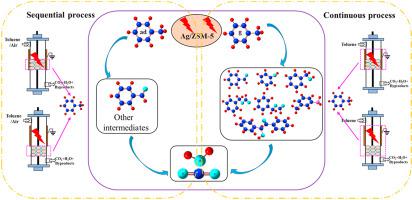Journal of Cleaner Production ( IF 9.7 ) Pub Date : 2020-09-19 , DOI: 10.1016/j.jclepro.2020.124251 Xin Yu , Xiaoqing Dang , Shijie Li , Jinlong Zhang , Qian Zhang , Li Cao

|
In the non-thermal plasma catalysis system, VOCs degradation was significantly affected by the position of the catalyst, as well as operation mode. Hence, it is of great significance to evaluate the performance of In Plasma Catalysis (IPC) and Post Plasma Catalysis (PPC) systems for VOCs abatement using both continuous and sequential processes. Four packed-bed dielectric barrier discharge (DBD) systems were used to degrade toluene with different catalysts under diverse voltages in this study. Results showed that the IPC mineralization rates were higher as compared to PPC, regardless of whether the continuous or sequential processes was used, and irrespective of the applied voltage and type of packed catalyst (e.g. 77.00% and 96.06% in SPPC and SIPC at 20 kV with Ag/ZSM-5 packed). However, PPC was superior to IPC in O3 and N2O reduction. As the applied voltage was raised, the mineralization rate in different reactors increased significantly, yet CO2 selectivity was insusceptible to voltage variation. NTP alone exhibited a mineralization rate and CO2 selectivity of 9.67%∼22.62% and 53.85%∼58.26%, respectively. While the mineralization rate and CO2 selectivity were remarkably improved with the presence of Ag/ZSM-5 (19.08%∼41.59% and 93.99%∼95.91% in CIPC). With respect to different catalysts investigated in this study, at 20 kV, Ag/ZSM-5 exhibited the highest mineralization rate - 96.06% in SIPC, and CO2 selectivity - 98.43% in SPPC; while the lowest concentrations of O3 (40 ppm) and N2O (8.01 ppm) were obtained in the Mn/ZSM-5 packed bed reactor. Possible reaction mechanisms were also proposed by analyzing the organic intermediates that were produced during continuous and sequential treatments, and remained in the adsorbents of IPC and PPC reactors.
中文翻译:

在介质阻挡放电反应器中通过连续和顺序过程进行等离子体内和等离子体催化减少甲苯的比较
在非热等离子体催化系统中,VOC的降解受到催化剂位置和操作模式的显着影响。因此,使用连续和连续过程评估用于降低VOC的等离子催化(IPC)和等离子催化(PPC)系统的性能具有重要意义。在本研究中,使用四个填充床介质阻挡放电(DBD)系统在不同的电压下用不同的催化剂降解甲苯。结果表明,与使用PPC相比,无论采用连续工艺还是顺序工艺,以及所施加的电压和填充催化剂的类型如何,IPC的矿化率均高于PPC(例如,在20 kV的SPPC和SIPC中为77.00%和96.06%装有Ag / ZSM-5)。但是,PPC在O 3中优于IPC和N 2 O简化。随着施加电压的升高,不同反应器中的矿化速率显着提高,但CO 2选择性不受电压变化的影响。单独的NTP显示出矿化率和CO 2选择性分别为9.67%〜22.62%和53.85%〜58.26%。Ag / ZSM-5的存在使矿化速率和CO 2选择性显着提高(CIPC中为19.08%〜41.59%和93.99%〜95.91%)。对于本研究中研究的不同催化剂,在20 kV时,Ag / ZSM-5的最高矿化率达到SIPC的96.06%,而SPPC的CO 2选择性达到98.43%。而最低的O 3(40 ppm)和N在Mn / ZSM-5填充床反应器中获得2 O(8.01 ppm)。通过分析连续和顺序处理过程中产生的并保留在IPC和PPC反应器吸附剂中的有机中间体,还提出了可能的反应机理。











































 京公网安备 11010802027423号
京公网安备 11010802027423号